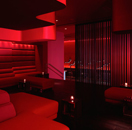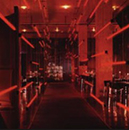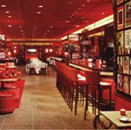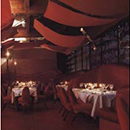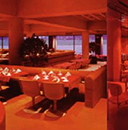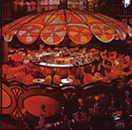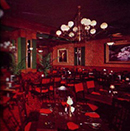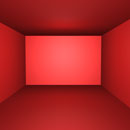
Red Room
Red Room, one of the oldest European archetypes, is a room in which all walls are rendered in a monochromatic red, a technique often used to create contrast and autonomy between one room and another. If Red Room describes a space filled with red light, then it is a subset of Color Flood. more
Red Room | Restaurant
application
In restaurants, Red Room describes a monochromatic red treatment of wall, floor and furnishings, and increasingly, the use of lighting.
research
Red is both bright and deep, a color that has been used throughout history as a representation of sacredness in many cultures. A Red Room is often symbolic—of royalty, romance, love, heroic virtue. Red symbolizing romantic quality is apparent in the Moulin Rouge cabaret (1889) owned by Josep Oller and Charles Zidler and built by an architect, Willette, in the district of Montmartre, Paris.1 The cabaret offered a provocative musical entertainment for adult visitors.
Red also demands attention. “Red has been appropriated for exhibition spaces in museums throughout time, especially when the objects were associated with 14th to 18th century European paintings, such as English, French, Dutch, and Italian drawings. Thierry Despont, a gallery designer for the Getty Center in Los Angeles, created red rooms for the exhibition of Italian paintings from 1500 to 1600 and French Decorative Arts from 1660 to1710. The Fogg Museum of Art in Boston has many red rooms of 14th to 18th century Dutch, French, and Italian paintings. In these Red Rooms, the color red conveys a noble, imperial quality of each painting.”2 Apart from royalty and romantic properties, red demands attention and creates excitement in exhibition spaces. This provocative and energizing quality has often been used in children's museums and science museums. In contemporary art museums, however, designers or artists sometimes employ this provocative, expressive quality of red for their contemporary installations.3
The English Victorians displayed pictures against deep red backgrounds, making gold frames appear especially rich. Henri Matisse’s Red Room is the first usage in 20th century paintings. This painting portrays a woman in a red dining room consisting of the same tone of red wall paper and the table cloth juxtaposed with an outside scene of green and blue. Curvy lines and warm colors make the red symbolize romance and love in this painting.
In the 21st century, many artists, such as Hans Hofmann, Josef Albers and Kartwig Kompa studied color, and they produced works using monochromatic red. In a 2003 exhibition titled “Seeing Red” held at Bertha and Karl Leubsdort Art Gallery in New York City, more than fifty artists presented approximately 100 works on contemporary nonobjective paintings that are produced only with color red. These artists influenced succeeding generations of artists towards understanding the significance of color experience for painting.4
Interest in red extends beyond the field of art. The Red Velvet Room in Chiswick House, England, designed in 1729 by William Kent, may be the first instance of its use in a house. However, Chiswick’s Red Room also served a gallery room in proximity of the Blue Velvet room. The walls in the Red Velvet room were hung with crimson velvet and the twenty eight pictures were arranged in a clearly defined pattern. Half of the pictures were a religious nature, either portraits of clerics or paintings of the Holy Family, and others were portraits or mythological subjects. Around the walls were eight hilt back stools, upholstered to match the wall hangings.5
One of three parlors in the White House, the Red Room, was a place for Senators and Congressmen invited by Dolley Madison for a regular Wednesday night social occasion in 1809. The Red Room was furnished in the Empire style of 1810-30 with rich crimson furniture. The room was the favorite sitting room of Mrs. Lincoln; it was where she received private calls every evening in the week when in town, and where the President usually met his friends socially after dinner.6 The Red Room has undergone a renovation in 1962, and recently the wall covering has changed to broadly patterned flat damask in a rich tone of red.7
In China colors were important factors in establishing Chinese society. For example, the region of Huang Di Dynasty, better known as Yellow Empire (2697BC – 2598BC), worshiped yellow, the symbol of farming. The color red represents happiness and luck. During the years of the Communist’s takeover red was a symbolic color for blood and death. However, after the Communist period, red has been China’s most popular color for its meaning of prosperity and good luck. In the west, many Chinese restaurants use red for this reason.8 Madam Wu’s Garden (1970) designed by Guy Moore in Santa Monica, California illustrates the use of Chinese red (vivid red to red-orange) for walls, floor and chairs in a contemporary interior. Randomly placed white squares on the wall surface, and white tablecloths, break the color intensity. Were it not for the Chinese-motif chargers on the table tops, one might not recognize the interior as Chinese.9
From 1960 through the 1980 decade, deep reds, including burgundy, ruled as popular colors for both high-style and ordinary restaurants. The Steer Palace (1969) in New York City10 and other steak houses across the United States appear to have been inspired by Victorian parlors, especially in their use of red flower printed wallpapers (including flocked papers), deep red carpets, and velvet upholstery. These interiors tended to be dark, lit by a central chandelier, and they were acoustically muted due to soft materials.
Another reason why designers choose red for restaurant environments is because they believe that “people look good there.” Red is thought to compliment all skin tones. The dining/disco space of Doubles (1980) could aptly be called “red-out,” in that designer Valerian Rybar finished all planar surfaces and all furnishings in brilliant saturated reds. Reflective wall surfaces and a large ceiling panel enables the interior to glow with intensity. 11
In the 21st century restaurants Red Room is achieved through unique techniques, such as new lighting techniques, as well as new and unexpected materials. In Georges Restaurant (2000) in Paris, designers Dominique Jakob and Brendan MacFarlane created “blobular” forms of sculpted aluminum shells which effectively blur the boundaries between planes and break down a massive open space. Removing planar edges and corners disrupts perceptions; the interior is no longer a traditional room, but a red grotto.12
Using new lighting technologies Stephane Dupoux designed the Pearl Restaurant and Lounge (2000) in Miami, Florida by creating a white space and then infusing the blank canvas with colored light.13 Using orange neon lighting at the top, and purple at the bottom, the space is swathed in red and amethyst light. This is an example of White Out transformed into a surrealistic Red Room solely with the use of lighting.
The Red Room & Cocktail Lounge designed by Fun Display in San Francisco (2003) is appointed with contrasting textures and materials ranging from smooth and shiny (glass, polished floor) to opaque and heavy (velvet, leather seating). However, it is the lighting that contributes the most to the spatial experience. Exposed lamps, suspended as pendants, are distributed unevenly where they reflect off the tinted-red glass of the window panes.14 The saturation of color and deeply upholstered booths and chairs is a contemporary reiteration of Chinese Red restaurants, steak house reds, and 1940s supper clubs.
Evidence is strong that Red Room is a deeply engrained design practice in western restaurant design, and the typology can be traced to various cultural influences. From the 1960s to the present trade magazines offer a wide array of applications.15
end notes
- 1) Jacques Pessis and Jacques Cre´pinean, The Moulin Rouge (New York : St. Martin’s Press, 1990), 11.
- 2) Joori Suh, “Theory Briefs: Contemporary Interior Design in Museums and Exhibition Spaces.” (M.A. Thesis, Cornell University, 2004), 24. For color symbolism, see Robert F. Ladau, Brent K. Smith, and Jennifer Place, Color in Interior Design and Architecture (New York: Van Nostrand Reinhold, 1989), 69 and M. Luckiesh, The Language of Color (New York: Dodd, Mead and Company, 1918), 103.
- 3) Joori Suh, “Theory Briefs: Contemporary Interior Design in Museums and Exhibition Spaces,” 24.
- 4) Michael Fehr, Sanford Wurmfeld, ed., Seeing Red: On Nonobjective Painting and Color Theory (Cologne: Salon Verlag, 2004), 36.
- 5) T. S. Rosoman, “The Decoration and Use of the Principal Apartments of Chiswick House, 1727-70,” The Burlington Magazine 127, no. 991 (1985), 668.
- 6) WhiteHouseMuseum, “Red Room,” WhiteHouseMuseum.org, http://www.whitehousemuseum.org/floor1/red-room.htm
(accessed 21 August 2008) - 7) Ethel Lewis, The White House: An Informal History of its Architecture, Interiors and Gardens (New York, Dodd, Mead & Company, 1937), 314.
- 8) Maurice Freedman, ed., Family and Kinship in Chinese Society (Stanford, Calif.: Stanford University Press, 1970), 177.
- 9) Madam Wu’s Garden [1970] Guy Moore, Santa Monica, California in “For Exotic Chinese Dining,” Interior Design 41, no. 4 (April 1970): 147.
- 10) The Steer Palace [1969] John B. Maurer, AID; New York City in “Frisco 1890,” Interior Design 40, no. 4 (April 1969): 201.
- 11) Doubles [1980] Valerian Rybar; New York City in Edie Lee Cohen, “Doubles,” Interior Design 51, no. 4 (April 1980): 235.
- 12) Georges Restaurant [2000] Dominique Jakob and Brendan MacFarlane; Paris, France in Claire Downey, “Georges Paris,” Architectural Record 188, no. 9 (Sept. 2000): 135.
- 13) Pearl Restaurant & Champagne Lounge [2000] Stephane Dupou;, Miami, Florida in Michael Webb, “Fuchsia Shock,” Hospitality Design 24, no. 1 (Jan/Feb, 2002): 61; Bethan Ryder, Restaurant Design (New York : Abbeville Press, 2004), 80.
- 14) Red Room & Cocktail Lounge [2003] Fun Display; San Francisco, California in Charles Doell and Lorraine Farrelly, Bar and Restaurant Interior Structures (Chichester: Wiley-Academy, 2003), 166-169.
- 15) Evidence for the use and the chronological sequence of Red Room as a restaurant archetype was developed from the following sources: 1960 Circus Circus Casino [1969] Rissman & Rissman Associates; Las Vegas, NV in "Circus Circus," Interior Design 40, no. 3 (Mar. 1969): 99; PhotoCrd: Anonyous; The Steer Palace [1969] John B. Maurer; New York City in "Frisco 1890," Interior Design 40, no. 4 (Apr. 1969): 201; PhotoCrd: Anonymous / 1970 Horseshoe Bar, Gatsby's Restaurant [1970] Joseph Braswell, AID, Interior Design New York City in "The Greats at Gatsby's," Interior Design 41, no. 4 (Apr. 1970): 137; PhotoCrd: Anonymous; Madam Wu's Garden [1970] Guy Moore, AID, Interior Design; Santa Monica, CA in "For Exotic Chinese Dining," Interior Design 41, no. 4 (Apr. 1970): 147; PhotoCrd: Leland Y. Lee; Cooky's Steak Pubs [1971] David Laurence Roth, Interior Design; Green Acres, New Rochelle, Yonkers, NY in Anonymous, "Cooky's Steak Pubs," Interior Design 42, no. 4 (Apr. 1971): 132; PhotoCrd: Anonymous; Dining Complex, E.R. Squibb and Sons Headquarters [1972]; Jerome J. Sincoff, Principal, David Shuttle, Designer, HOK; Lawrenceville, NJ in "HOK," Interior Design 43, no. 9 (Sep. 1972): 137; PhotoCrd: Alexandre Georges / 1980 Doubles [1980] Valerian Rybar; New York City in Edie Lee Cohen, "The Greats at Gatsby's," Interior Design 51, no. 4 (Apr. 1980): 235; PhotoCrd: Jamie Ardiles-Arce; Little Italy Restaurant [1984] Charles E. Fisk, Jr., AIA, The Architect's Office; Austin, TX in Anonymous, "Little Italy's Relocus," Interior Design 55, no. 6 (June 1984): 251; PhotoCrd: Charles Fisk / 1990 Taxim Nightpark [1996] Branson and Coates; Istanbul, Turkey in Olivier Boissière, ed., Outstanding Bar and Restaurant Designs (Paris: Telleri, 1998), 36; PhotoCrd: Shinkentiku; Tizi Melloul [1999] Suhail Design Studio; Chicago, IL in Martin M. Pegler, Contemporary Restaurants and Bars (New York: Visual Reference Publications, 2004), 93; PhotoCrd: Doug Fogelson / 2000 Georges [2000] Jakob+MacFarlane; Paris, France in Claire Downey, "Georges, Paris," Architectural Record 188, no.9 (Sep. 2000), 135; PhotoCrd: ArchiPress; Strip House [2001] Rockwell Group; New York, NY in Claire Downey, "Strip House, " Interior Design 72, no.14 (Nov. 2001), 114; PhotoCrd: Paul Warchol; Astro [2002] Michael Young; Reykjavik, Iceland in Clifford A. Pearson, "ASTRO, " Architectural Record 188, no.9 (Nov. 2002), 174; PhotoCrd: Ari Magg; Spoon Byblos [2002] Patrick Jouin; St. Tropez, France in Joachim Fischer, ed., Restaurant Design (Stuttgart, Germany: Daab Press, 2004), 212; PhotoCrd: Romeo Balancourt; Pearl [2002] Stephane Dupoux; Miami, FL in Michael Webb, "Fuchsia Shock, " Hospitality Design 24, no.1 (Jan./Feb. 2002), 61; PhotoCrd: Mike Butler; Azumitei [2003] | Hashimoto Yukio Design Studio Inc.; Tokyo, Japan in Joachim Fischer, ed., Restaurant Design, 144; PhotoCrd: Martin Nicholas Kunz; Auberge [2007] Patrick Jouin; Alsace, France in Ian Phillips, "A Feast for the Eyes, " Interior Design 78, no.9 (July 2007), 211; PhotoCrd: Eric Laignel; Paperfish [2008] Clive Wilkinson Architects; Los Angeles, CA in Edie Cohen, "No Reservations," Interior Design 79, no.9 (Mar. 2008), 280; PhotoCrd: Benny Chan/Fotoworks; Red Prime Steak [2008] Elliott + Associates Architects; Oklahoma City in Mark McMenamin, "Dinner for Seven," Interior Design 79, no.9 (July 2008), 261; PhotoCrd: Scott McDonald, Hedrich Blessing.
bibliographic citations
1) The Interior Archetypes Research and Teaching Project, Cornell University, www.intypes.cornell.edu (accessed month & date, year).
2) Cho, Jasmin. “Theory Studies: Archetypical Practices of Contemporary Restaurant Design.” M.A. Thesis, Cornell University, 2009, 27-37.

